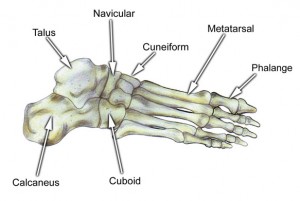The navicular bone is one of the tarsal bones of the foot. Similar to the yoga pose navasana, The navicular bone is so named because of its resemblance to a boat. The navicular bone articulates with a number of bones including the talus, the cuboid and the three cuneiform bones.
The navicular bone plays an essential role in the use and stability of the foot’s inner arch and is essential to good movement patterns and posture. The inner arch is made up of the following bones:
- Calcaneus
- Talus
- Navicular
- Cuneiforms
- First three metatarsals
The navicular bone is the highest point and the keystone of the arch as it sits between the talus and cuneiforms. The inner arch of the foot provides a great deal of the body’s weight bearing and shock absorption. The talus bears much of the weight and then transfers it forward through the navicular to the rest of the foot through the cuneiforms.
The tibialis posterior is the only muscle that attaches to the navicular bone (it attaches to all of the tarsal bones but the talus) and it is also the main muscle called upon to support the inner arch. It gets help from tibialis anterior, flexor hallucis longus and flexor digitorum longus but it bears the brunt of the load. Walking should involve the endless lengthening and shortening of the tibias posterior (and the rest) with each step. Engagement of the tibialis posterior lifts the navicular and inner arch up and then it releases to allow for the arch to drop before engaging and lifting up again enabling the proverbial spring in your step.
***



